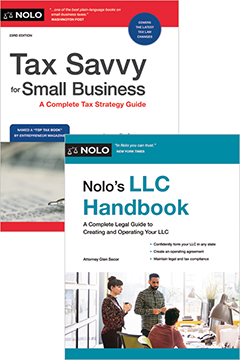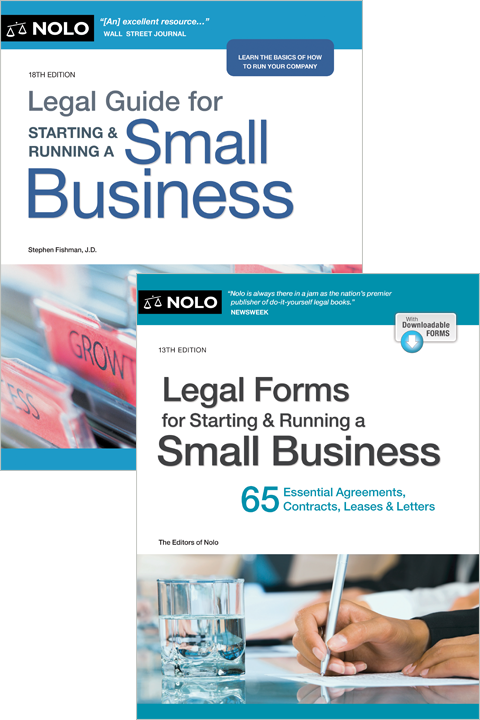Most single-member LLCs can elect to be taxed as an S corporation. But is this tax election the best fit for your small business?
Going into business by yourself can be a challenge. As the sole decision maker, you'll be tasked with evaluating your business's current needs and planning for the future. Choosing an entity and tax structure for your business will be one of your first crucial decisions.
If you've decided to form a limited liability company (LLC), specifically a single-member LLC (SMLLC), you should consider whether electing to be taxed as an S corporation is the best next step.
Tax Classifications for Single-Member LLCs
When an LLC has only one owner, the IRS, by default, treats the SMLLC as a disregarded entity (sometimes called a "sole proprietorship") for tax purposes. When your SMLLC is treated as a disregarded entity, the IRS effectively disregards or ignores the separate existence of your company. You (as the owner of the SMLLC) and the SMLLC itself (your company) are treated as one and the same.
Your SMLLC will automatically be treated as a disregarded entity. You don't need to file any special tax forms to claim this tax classification. Under this classification, you'll report your business income and expenses on Schedule C of your personal tax return.
Available Tax Elections: C Corporation and S Corporation Elections
An SMLLC doesn't have to be taxed as a disregarded entity. Instead, you can elect to have your SMLLC taxed as either:
- a C corporation by filing IRS Form 8832, Entity Classification Election, or
- an S corporation by filing IRS Form 2553, Election by a Small Business Corporation.
A C corporation is a regular corporation where both the corporation and the shareholders are taxed. If you elect to have your SMLLC taxed as a C corporation, then your company will be taxed on its profits, and you'll be taxed on the dividend payments you receive from your company. C corporations are taxed at the entity and shareholder level, resulting in double taxation.
An S corporation is still technically a corporation, and it shares some features (and terminology) with a regular corporation. For example, both C corporations and S corporations are:
- formed as corporations at the state level
- governed by corporate bylaws
- owned by shareholders, and
- run by a board of directors.
But for the purposes of taxes, S corporations differ from C corporations in important ways. An S corporation—unlike a C corporation—is a pass-through tax entity. As a pass-through entity, the S corporation itself isn't taxed. Instead, the profits pass through the corporation (SMLLC) to the shareholders (members), and the members pay taxes on their share of the income distributions.
So if your SMLLC is taxed as an S corporation, you, as the sole member and shareholder of the SMLLC, will pay income taxes on the SMLLC's profits. You'll report and pay income tax for your SMLLC on your personal tax return.
Because an S corporation is a pass-through tax entity, its tax treatment is similar to that of a disregarded entity or partnership. It might make the most sense for you to keep your default tax status as a disregarded entity. However, S corporations have some unique advantages over disregarded entities (discussed later). You should consider these benefits and the potential drawbacks when deciding whether to elect S corporation status.
IRS Requirements for S Corporation Tax Election
The IRS has strict eligibility requirements for S corporations. As an SMLLC, you should be able to easily meet these requirements and qualify for S corporation tax status.
To qualify for S corporation tax status, your SMLLC must:
- be a domestic corporation or domestic entity that can elect to be treated as a corporation (which your SMLLC qualifies for as long as you formed your SMLLC within the United States)
- have fewer than 100 shareholders (your SMLLC will only have one shareholder: you)
- not have shareholders that are partnerships, corporations, or non-resident aliens (if you're a U.S. resident, you should meet this qualification); and
- have only one class of stock (which should be the case as an SMLLC).
In general, your SMLLC will likely qualify for S corporation status. You'll need to submit the appropriate paperwork to the IRS to make this election (as explained later).
How Do S Corporations Pay Taxes?
As mentioned before, an S corporation is a pass-through tax entity. Your SMLLC's profits pass through the company to you as the sole member. You'll pay taxes on your LLC's profit. However, when your SMLLC is taxed as an S corporation, you'll divide your SMLLC profits into two categories:
- salary, and
- distributions (sometimes referred to as "dividends").
You'll pay different kinds of taxes on each type of income.
Paying Payroll Taxes on Your Salary
If your SMLLC elects to be taxed as an S corporation, then you'll be considered an employee of your SMLLC. If you kept your default tax status as a disregarded entity, then the IRS would consider you to be "self-employed." When you're self-employed, you pay self-employment taxes as an individual. When you're considered an employee of your SMLLC, you pay payroll taxes as both an employer and an employee. We'll get into the difference and potential advantages of reducing your self-employment tax burden later.
For now, let's assume you've elected to have your SMLLC taxed as an S corporation. Because you've made this election, the IRS now classifies you as an employee of your SMLLC, meaning your SMLLC is your employer. You must pay yourself a salary as an employee—and that compensation must be reasonable. In other words, you can't have your SMLLC make a $100,000 profit but only take a $10,000 salary, scooping up the remaining $90,000 as distributions.
Once you've paid yourself a salary, you'll need to pay taxes on that salary. Payroll taxes include:
- Social Security tax: The employer and employee split this tax evenly. You and your SMLLC will each pay a 6.2% tax on your wages, totaling 12.4%.
- Medicare tax: The employer and employee split this tax evenly. You and your SMLLC will each pay a 1.45% tax on your wages, totaling 2.9%.
- Federal unemployment tax (FUTA): The employer is solely responsible for this tax. The employer will pay 6% on the first $7,000 in wages paid to each employee. Employers can apply a tax credit for state unemployment taxes paid.
- State unemployment tax: In most states, only employers pay this tax. Your state will set the unemployment tax rate.
Social security and Medicare taxes are together referred to as a "FICA" tax, short for Federal Insurance Contributions Act. Your portion of the FICA tax should be deducted from your paycheck.
Paying Income Tax on Distributions
After you've collected your salary, you can claim the rest of your SMLLC's profits as a distribution. A distribution isn't subject to any special taxes. Instead, you'll simply pay income tax on your distributions. You'll also need to pay income tax on your salary just as you would with any other salary or wages.
For example, suppose your SMLLC made a profit of $90,000. You pay yourself a $65,000 salary and take the remaining $25,000 as a distribution. Based on your and your spouse's combined income, your federal personal tax rate is 22%. You'd owe the federal government $5,500 in taxes—$25,000 x 0.22—just on your distribution. You'd still need to additionally pay income tax on the $65,000 you received as a salary.
Benefits of Electing S Corporation Tax Status
Both disregarded entities and S corporations are pass-through tax entities. So, you won't gain a pass-through advantage by electing to be taxed as an S corporation. But you'll find other important benefits to electing to be taxed as an S corporation as an SMLLC, namely decreased employment taxes.
When your SMLLC is taxed as a disregarded entity, you're responsible for paying self-employment tax on your SMLLC's profits. "Self-employment tax" is a combination of Social Security and Medicare taxes. When you're an employee, this combination tax is referred to as a FICA tax, and you and your employer split this tax evenly (as explained earlier).
As of 2025, the self-employment tax rate is 15.3%, which includes a 12.4% Social Security tax and a 2.9% Medicare tax. So you'll need to pay a 15.3% self-employment tax on your SMLLC's profits in addition to your personal income tax rate.
However, as explained earlier, if your SMLLC elects to be taxed as an S corporation, then you'll be considered an employee of your SMLLC—as opposed to self-employed. As a result, you won't need to pay self-employment tax on your LLC income. Instead, your SMLLC will pay you a salary, and you'll pay employment taxes on your salary. The rest of your SMLLC income can be taken as a distribution, free of employment (payroll) taxes.
If your SMLLC is highly profitable, lower employment taxes can be a big money saver. As an S corporation, you only have to pay payroll taxes on the portion of your profits you take as salary and not on all of your profits. But make sure the IRS will consider your salary as "reasonable compensation."
You can find other benefits by being taxed as an S corporation. For example, as an S corporation, your SMLLC can take out and contribute to a retirement account for you. As an employee, you can defer part of your salary as contributions to your retirement account.
Disadvantages of Electing S Corporation Tax Status
While you might benefit from some tax savings, electing to be taxed as an S corporation isn't without some drawbacks:
- You'll be responsible for additional tax filings. As an SMLLC, you only needed to report your company's income on your personal tax return. As an S corporation, you'll need to file the paperwork to make the election and then file IRS Form 1120-S, U.S. Income Tax Return for an S Corporation, each year. You can learn more about the tax forms you need to file in our article on S corporation tax filing requirements.
- You must implement and run payroll. Because you're an employee of your S corporation, you'll need to take on payroll responsibilities. You'll need to either devote your own time to this accounting responsibility or pay a third party to do it for you.
- You must pay unemployment taxes. As an employer, your SMLLC must pay unemployment taxes to the state and federal governments.
- Fringe benefits are taxable. With an S corporation, most benefits you receive as an employee are taxable because you own more than 2% of the company. Fringe benefits that are taxable for S corporation owners include health insurance, meals, transportation, and lodging.
Before electing to be taxed as an S corporation, you should speak with a lawyer or tax expert about the pros and cons of this tax status. These professionals can also provide guidance to make sure your SMLLC is properly organized, meets all IRS guidelines, and that re-classification is financially worth your while. You should also be aware of the five questions to ask before forming an S corporation.
How to Elect S Corporation Tax Status as a Single-Member LLC
After you've determined that your SMLLC qualifies as an S corporation and this classification is the best fit for your business, you can officially make the election. You elect to have your SMLLC taxed as an S corporation by filing IRS Form 2553, Election by a Small Business Corporation. You can have an attorney or tax professional prepare the form for you, but you should sign the form yourself.
You must make the election either:
- within two months and 15 days after the start of the tax year, or
- any time during the previous tax year.
After you've made the election, your SMLLC will be treated as an S corporation until you've revoked the status. In other words, you don't need to make the election every year.
After your SMLLC becomes an S corporation, you must file IRS Form 1120-S, U.S. Income Tax Return for an S Corporation, annually by March 15. In addition, your SMLLC is responsible for providing you, as the sole owner and member, with a Schedule K-1. You'll use your K-1 to report your share of your company's income (which should be 100%) on your personal taxes.
Additional Help With Electing an S Corporation Tax Status as an SMLLC
For additional information on any of the issues covered here, including avoidance of self-employment taxes and reasonable salaries, check the IRS website or consult with a tax professional.
For other general information related to taxation of SMLLCs, check out the other tax-related articles in the SMLLC section of our website. You can also read Nolo's Guide to Single-Member LLCs, by David M. Steingold (Nolo).
- Tax Classifications for Single-Member LLCs
- How Do S Corporations Pay Taxes?
- Benefits of Electing S Corporation Tax Status
- Disadvantages of Electing S Corporation Tax Status
- How to Elect S Corporation Tax Status as a Single-Member LLC
- Additional Help With Electing an S Corporation Tax Status as an SMLLC



